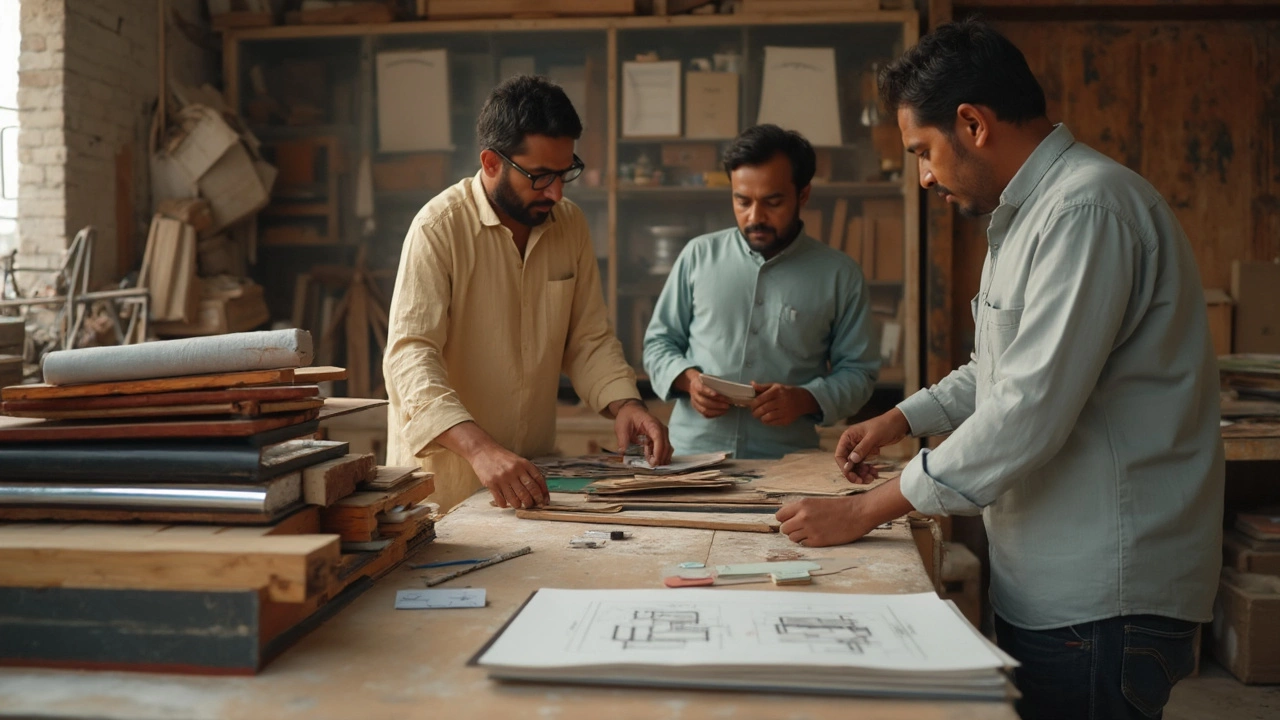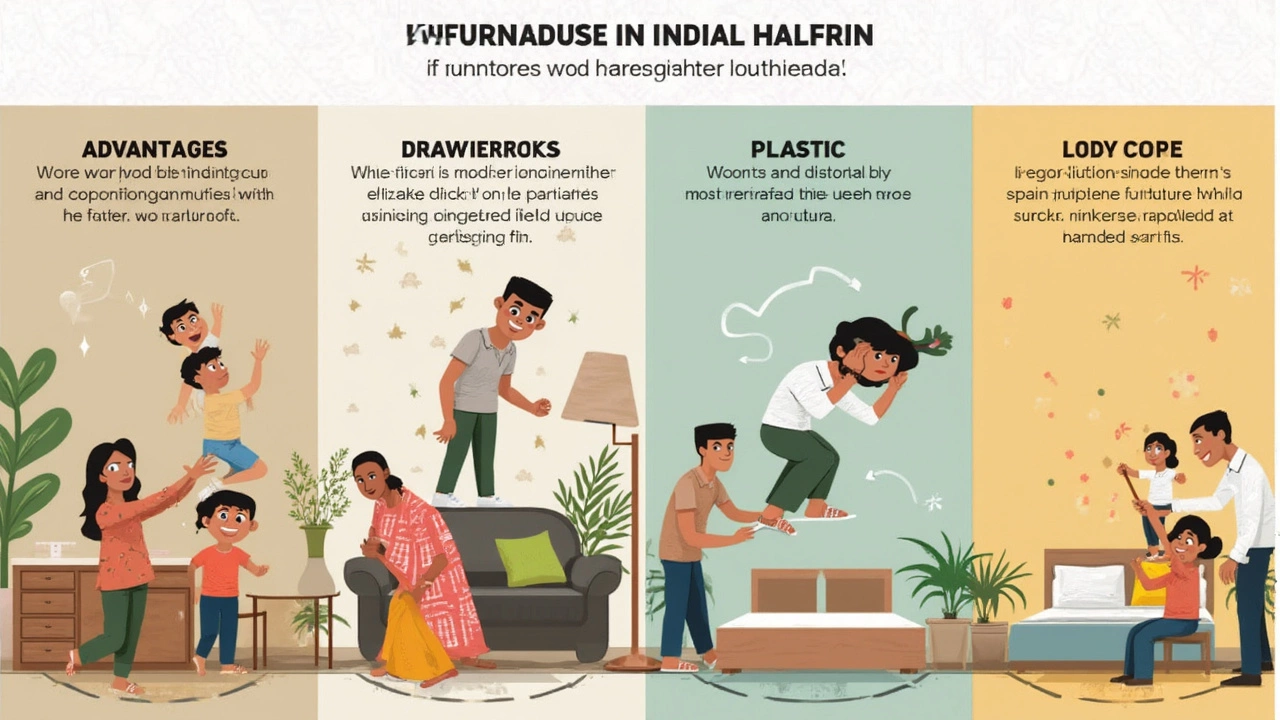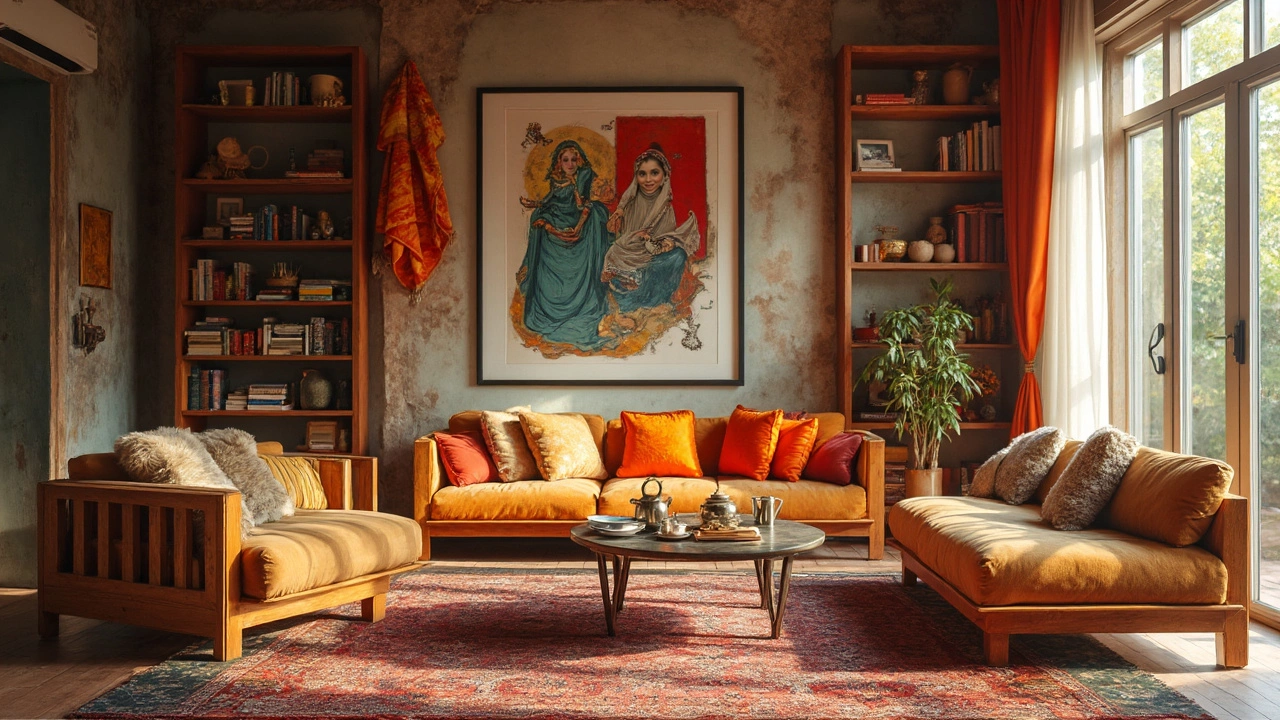Walk into any furniture store in India and you'll see endless options: shiny pieces made from teak, basic plywood beds, stylish metal chairs, and even quirky plastic sofas. But what's really worth your money? The material of your furniture isn't just about looks—it's about how long things last, dealing with Mumbai humidity or Delhi dust storms, and whether your new table will fall apart after a year of use.
Choosing the wrong material can throw your wallet and your peace of mind out the window. Some woods warp in the monsoon. Certain metals rust if you sneeze on them. Engineered boards sound fancy until you spill chai or your kid jumps on the bed. So before you splash out, it's smart to know what works in India’s unique climate and why some materials win over others here.
- Why Material Matters in Indian Homes
- Solid Wood: The Classic Choice
- Modern Materials: Engineered Wood and More
- Metal, Plastic, and Hybrid Options
- Tips for Choosing the Right Material
Why Material Matters in Indian Homes
Picking the right material for your furniture isn’t just about style—it's about getting value that lasts, especially with the unique weather and living habits in India. Across the country, we deal with everything from super dry winters in Rajasthan to soggy monsoon months on the coast. Not every furniture material holds up the same way.
For example, solid wood (like teak or sheesham) stays strong in humid conditions, while low-quality plywood might bubble or bend. If you live in a crowded city, dust and grime settle fast and materials like glass or white plastic turn dirty before you can blink. Wood can scratch, metal can rust, and anything with fabric fights sweat, stains, and pet hair daily. Choosing wrong means more repairs, more cleaning, and sometimes feeling like you just wasted your hard-earned cash.
As Ramesh Gupta, a third-generation furniture maker in Jaipur, explains:
“A bed made of good quality teak will last a lifetime, even with rough use and weather changes. But I often see people buy flashy items made from MDF or particle board, and then come back in two years asking how to fix a broken leg or warped top. The material decides 90% of your problems.”
If you have kids running around, something sturdy that won’t tip or split is a must. Got a balcony or open verandah? Skip cheap metal—monsoon rain can finish it off in a season. And if you’re investing in heavy pieces, remember you can’t just move them whenever you want—especially in small apartments.
So when you’re choosing furniture materials India offers, think about where you live, how you use the furniture, your budget, and even future repairs. It pays to ask sellers about water resistance, termite protection, and manufacturer warranties before you decide. A little homework now saves a lot of regret later.
Solid Wood: The Classic Choice
If you ask any old-school Indian carpenter about the best material for sturdy furniture, they’ll swear by solid wood. No surprise—solid wood, especially teak, sheesham (Indian rosewood), and sometimes mango wood, has held up in Indian households for generations. Why do so many families choose it time after time? Well, because it’s tough, looks great, and, if you take basic care, lasts literally for decades.
Teak is pretty much the gold standard in solid wood for furniture materials India—it naturally resists termites and humidity. Sheesham is next in line: it’s hard, less expensive than teak, and handles carving for those intricate chair legs and temple doors you see in North Indian homes. Mango wood is gaining popularity, mainly because it’s affordable and more environmentally friendly, as it uses wood from trees already harvested for fruit.
But let’s keep it real: solid wood isn’t all roses. Good teak, for example, costs a bomb. Plus, solid wood furniture is heavy, so don’t expect to easily rearrange your room. Big city apartments? It might not fit through the door. And with the rising cost of real wood, there’s always the risk of getting scammed with “teak finish” that’s actually veneered ply.
If you’re thinking solid wood, here are some quick tips:
- Check for cracks, knots, or signs of termites before buying. Real wood isn’t perfectly “smooth”—there’s always some texture or natural pattern.
- For humid cities like Chennai or Kolkata, stick to seasoned wood, so it doesn’t warp.
- Ask the seller about the source of the wood—Indian teak is different from imported versions, which often aren’t as durable in local conditions.
- Stick to local manufacturers or trusted brands. They’re less likely to sneak in cheaper substitutes.
Bottom line: If you have the budget, solid wood isn’t just a statement. It handles the Indian climate, brings warmth to your space, and, if you go with the right supplier, holds up for generations (your grandkids might actually inherit that dining table).

Modern Materials: Engineered Wood and More
If you’re on a budget or love furniture that’s lightweight and ready-to-assemble, engineered wood is something you’ve seen a lot. In Indian cities, flat-pack furniture made of MDF (Medium Density Fibreboard), plywood, and particle board is everywhere—think IKEA beds or those sleek TV units that cost less than your phone bill.
Plywood is probably the most common. It’s basically thin layers of wood glued together. Most wardrobes, cabinets, and modular kitchens use plywood, especially the waterproof BWP (Boiling Water Proof) type. It can handle monsoon season better than regular solid wood, and you don’t need to panic if you spill water during your morning rush. ISI-marked plywood is tougher and usually lasts longer.
MDF, on the other hand, is smoother and perfect for painted finishes. You’ll see it in cheaper shelves or decorative wall panels. But it swells up easily if water seeps in. So, keep it far from kitchens or bathroom areas.
Let’s get real—these materials are not as sturdy as solid wood, but they do shine in a few key areas:
- Super affordable compared to hardwood furniture
- Comes with a neat, uniform finish—great if you want modern, minimal looks
- Easy to move around, especially if you live in a rental or shift homes often
Indian furniture manufacturers use these panels a lot for urban apartments where people want fast, good-looking options without splurging. But watch out—longevity drops if you overload shelves or ignore basic care.
| Material | Main Use | Cost (Rs per sq ft)* | Water Resistance | Expected Lifespan |
|---|---|---|---|---|
| Plywood (BWP) | Cabinets, beds | 70-120 | High | 10-15 years |
| MDF | Shelves, painted pieces | 35-60 | Low | 5-8 years |
| Particle Board | Budget furniture | 20-40 | Very Low | 3-5 years |
*Prices as of 2025 in major Indian cities
Beyond wood, you’ll also see glass tabletops and laminates stuck over engineered boards for longer life and funky colors. The trick is to check if edges are sealed well to keep out moisture and ask the shop about warranties—they can be a life saver if a piece collapses early. If your aim is to get the most out of every rupee without dealing with a truckload of maintenance, engineered wood is a strong contender—just buy smart, not blind.
Metal, Plastic, and Hybrid Options
Not everyone in India wants solid wood furniture—sometimes you're looking for something light, budget-friendly, or easy to move around when you need to shuffle the living room for guests or clean under the bed. That's where metal, plastic, and mix-and-match options step in. Each has its pros and cons, and certain choices just work better in the Indian context.
Metal furniture is super popular for stuff like cots, bunk beds, and dining sets in cities from Chennai to Chandigarh. Powder-coated steel and iron pieces stand up well to daily use, especially in rental homes or busy hostels. The trick is to look for rust-resistant finishes, since Indian humidity (especially along the coasts) can quickly turn cheap or untreated metal into a mess of flakes and rough edges. Aluminum is lightweight and practically rustproof, but it's usually pricier than standard steel. Before you buy, check that the welds are smooth and neat—bad joinery means wobbles and short life.
Plastic furniture is all about zero maintenance. Stackable stools, flashy patio chairs, school benches—you see them everywhere, thanks to brands like Nilkamal. On the plus side, it won't rot or attract termites, which is a real headache with wooden stuff in places like Kerala. The downside: plastic warps with too much sun exposure, and once cracked, there's no real fixing it. For outdoors, stick to UV-stabilized plastics if you don’t want your chairs to fade in just one summer.
Hybrid options mix materials to solve common problems. Think wooden frames with metal legs or glass tops combined with engineered board below. For example, metal-legged dining tables with a wooden top cope better with Mumbai’s monsoon floods than all-wood ones. Hybrids can look more stylish and give you decent durability, but pay attention to how the pieces are joined together. Shaky joints or poor glue jobs pretty much guarantee short-term use only.
- Choose powder-coated or stainless metal to avoid rust issues.
- If it’s plastic, ask if it’s UV-stabilized—important for balconies or garden areas.
- With hybrids, check for solid joints and properly finished edges. Avoid anything that feels unstable.
One quick tip: If you’re planning to move often or just want furniture for a few years, metal and plastic make sense. But for areas where people sit or sleep a lot, hybrids and higher-quality builds last longer and look less "temporary" over time. The right material always matches your lifestyle—not just the latest trend in the store.

Tips for Choosing the Right Material
If you’re serious about getting furniture that actually lasts in India, skip the guesswork. Here’s how smart buyers make decisions that save money and headaches down the line.
- Check your climate. Wood like Sheesham and teak handles Indian humidity much better than cheap pine or softwoods, which can crack, bend, or even attract pests during the monsoon. If you're in a coastal city, opt for rust-resistant metal, like powder-coated steel or aluminum—regular iron will corrode fast.
- Think about usage. Is the furniture for heavy daily use, like a family dining table, or just the occasional nightstand? For heavy-traffic spots, invest in solid wood or thick, high-grade plywood rated above 15 mm. For more temporary pieces or decorative items, MDF or engineered boards do the trick.
- Watch for warranties. Reputable furniture manufacturers in India usually offer at least 1-5 years on solid wood items. If a piece with pricey finish or hardware has no warranty, that's your cue to look elsewhere.
- Check for termite treatment. In India, termite infestations are common. Always ask if wood is pre-treated (BWR or BWP labels for plywood mean they're safe). Don’t fall for sellers who can't prove this.
- Consider environmental and budget choices. Plastics and cheap boards are budget-friendly but tend to wear out quickly. Look for eco-rated or recycled options if you want sustainability, but always check how they’ll hold up in your city’s weather.
Here's a quick comparison to make it easier:
| Material | Durability (Years) | Water Resistance | Maintenance | Best Use |
|---|---|---|---|---|
| Teak/Sheesham | 15-25 | High | Low | Any solid furniture |
| Engineered Wood | 3-8 | Medium | Medium | Budget, light use |
| Plywood (BWR/BWP) | 8-15 | High | Low | Kitchens, cabinets |
| Metal (coated) | 8-12 | Medium | Low | Beds, outdoor |
| Plastic | 3-5 | High | Very low | Outdoor, kids’ stuff |
So, whether you want a classic piece in the living room or a quick utility buy, match your needs to the material and check for proper treatments. And just because a piece looks stylish doesn’t mean it suits Indian homes—sometimes, plain old solid wood is still the king for the furniture materials India topic.
